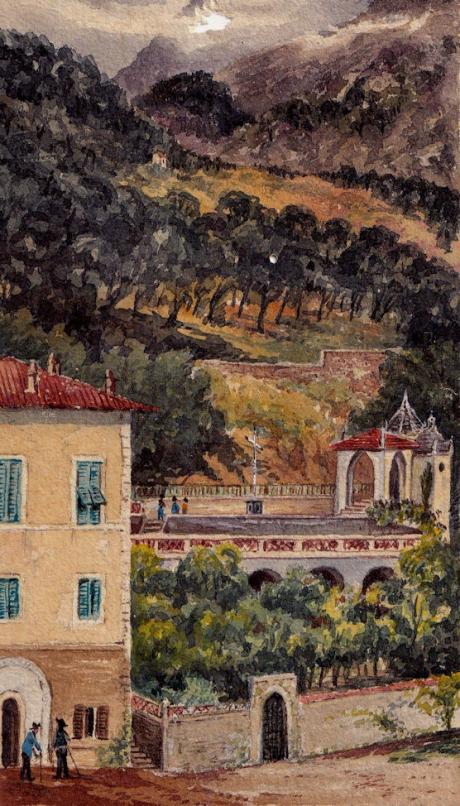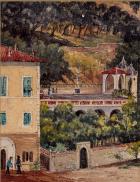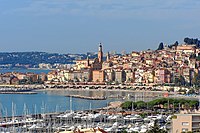inscribed signed with monogram and dateed on the reverse " View from 3rd Floor Hotel' des Angles Mentone E. T.L. 1874"
Menton written Menton in classical norm or Mentan in Mistralian norm; Italian: Mentone is a commune in the Alpes-Maritimes department in the Provence-Alpes-Côte d'Azur region on the French Riviera, close to the Italian border.
Menton has always been a frontier town. For centuries, it formed the border between Provence and Genoa. It has been French ever since the plebiscite of 1860, when it soon became a fashionable tourist centre with grand mansions and gardens. Its temperate Mediterranean climate is especially favourable to the citrus industry, with which it is strongly identified.
The Menton area has been inhabited since the paleolithic era, and is the site of the original "Grimaldi Man" find of early modern humans, as well as remains of Neanderthals and Cro-Magnons. In Roman times, the Via Julia Augusta, a road connecting Placentia (now Piacenza) with Arelates (now Arles) passed through Menton, running along the Rue Longue in the old town. The first major settlement occurred during the 11th century CE, when the Count of Ventimiglia constructed the Château de Puypin (Podium Pinum) on the Pépin hill, north and west of the modern town centre. During the 13th century, the seigneury of Puypin fell to the Vento family of Genoa who built a new castle along the Roman road, now the site of the Vieux-Château cemetery, providing the core around which the current town grew. Menton was thus incorporated into the Republic of Genoa. The first mention of Menton dates from 21 July 1262, in the peace treaty between Charles of Anjou and Genoa. Its position on the border between the Angevin-ruled Provence and the Republic of Genoa, which at the time claimed Monaco as its western limit, made it a coveted location.
Acquired in 1346 by Charles Grimaldi, Lord of Monaco, Menton was ruled by the Princes of Monaco until the French Revolution. Annexed during the Revolution, Menton remained part of France through the First Empire. It belonged to the district of Sanremo in the department of Alpes-Maritimes, which at the time included Monaco and Sanremo.
In 1814, Menton was included in a reconstituted principality of Monaco which, after Napoleon's Hundred Days in 1815, became a protectorate of the King of Sardinia. The Princes of Monaco were obliged to do homage to the King for Menton, although not for Monaco itself.
In 1848, Menton, along with its neighbour Roquebrune, seceded from Monaco, due at least in part to a tax imposed on lemon exports. They proclaimed themselves a "free city" during the 1848 revolutions related to the Italian Risorgimento, then two years later placed themselves under the protection of the Kingdom of Sardinia where they were administered by the House of Savoy for ten years.
The Treaty of Turin concluded on 24 March 1860 between the Kingdom of Sardinia and Napoleon III's France called for the annexation of the County of Nice to France, subject to a plebiscite, as a reward for French assistance in Italy's war against Austria. The plebiscite, with universal adult male suffrage, was held on 15 and 16 April 1860, and resulted in an overwhelming vote in favour of annexation (833 for versus 54 against in Menton and Roquebrune),despite complaints of rigged elections from, among others, Nice-born Italian nationalist Giuseppe Garibaldi. The county of Nice was thus annexed to France that June, and Napoleon III paid 4 million francs in compensation to the prince of Monaco, who renounced his rights in perpetuity on 2 February 1861.
The publication of Winter and Spring on the Shores of the Mediterranean (1861) by the English doctor James Henry Bennett had a profound effect on Menton, making it a destination for sufferers of tuberculosis. By the end of the 19th century, tourism was an important factor in Menton's growth. The town was popular with British and Russian aristocrats who built many of the hotels, villas, and palaces which still grace Menton today. Many of these hotels and palaces were pressed into service as hospitals during World War I to allow injured troops to recuperate in a pleasant climate.

Menton was the only sizable settlement captured by Italy during its invasion of France in June 1940. Following the armistice of 22 June 1940, two-thirds of the territory of the commune was annexed by Italy as terra irredenta. The annexation lasted until 8 September 1943.
Although officially returned to Vichy France, Menton was in fact occupied by Nazi Germany until its liberation by American and Canadian troops of the First Special Service Force on 8 September 1944.
Geography

Menton, nicknamed the Pearl of France, is located on the Mediterranean Sea at the Franco-Italian border, just across from the Ligurian town of Ventimiglia.
The fishing industry was devastated in the 1980s and 1990s due to a combination of overfishing and hypoxia in the bay. At the time, the devastation was erroneously attributed to the dubiously nicknamed "killer algae" Caulerpa taxifolia (a non-native Asian tropical green alga first discovered in the Mediterranean Sea adjacent to the Oceanographic Museum of Monaco in 1984) spread throughout the coastal sea floor. Later, sound scientific findings revealed that the seaweed was adept at absorbing pollutants and excess nutrients, actually aiding the recovery of native Posidonia sea grass and enhancing local fish populations and overall biodiversity.
Climate
Under the Köppen system, Menton features a hot-summer mediterranean climate (Csa). However, the milder winters (on average) and the warmer nights in summer (on average), compared to the rest of the French Mediterranean coastal area, provide Menton with a particular micro-climate, with significant warm-summer mediterranean climate (Csb) influences and characteristics, like coastal California and Oregon (experienced from Nice through Monaco and Menton, toward the Italian border) that is favorable to tangerine, orange and lemon groves, hence one of the town's symbols, the lemon. Winter frosts are extremely rare but may occasionally occur every few years. Likewise, summer temperatures are relatively moderate, rarely rising above 30 °C.
- ^ Mean monthly maxima and minima (i.e. the expected highest and lowest temperature readings at any point during the year or given month) calculated based on data at said location from 2009 to 2016. Extremes from 2009 to 2016 as well.
Townscape
-
The Pont Saint-Ludovic / Ponte San Ludovico border crossing point between Menton, France and Ventimiglia, Italy
Menton is known for its gardens, including the Jardin Serre de la Madone, the Jardin botanique exotique de Menton ('Le Val Rahmeh'), the Fontana Rosa, the Maria Serena garden, and the modernist gardens of Les Colombières. Le Val Rahmeh was established in 1905 by Englishman Sir Percy Radcliffe, the first owner of the gardens, and named for his wife. Villa Fontana Rosa was built in 1922 by Blasco Ibáñez, a Spanish novelist, and the gardens of the villa are now open to the public.
- The baroque basilica of Saint-Michel-Archange, with its belltower, was built in 1619 by the Genoese architect Lorenzo Lavagna.
- The Bastion Museum, which features decoration by Jean Cocteau, is located in the Bastion of the port of Menton. The bastion, built overwater in 1636 as an advance defense for the port by the Princes of Monaco, is now located at the shoreline.
- The wedding room at the Mairie (town hall) was painted in the 1950s by Cocteau, transforming it into a giant work of art.
- Menton is home to at least half a dozen beaches.
- Menton is notable for its Palissy majolica pottery depicting lemons.
- The historic covered market was built in 1898 by local architect Adrien Rey. The market is open every day from 5 am until 1 pm in the summer; in the winter, it opens at 5:30 am. Over 30 kiosks both inside and around the market sell local and imported vegetables. The Belle Époque structure was one of buildings constructed by the architect in the region.
- Next to the beach and the covered market is the Jean Cocteau Museum. It opened in 2011 and is close to the Bastion Museum.
- Mirazur is a French haute cuisine restaurant with three Michelin Guide stars. The World's 50 Best Restaurants list ranks Mirazur as the best restaurant in the world.









